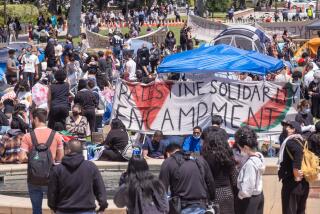Shi’ism and Social Protest edited by Juan R. I. Cole and Nikki R. Keddie (Yale University: $40, hardcover; $12.95, paperback; 325 pp.)
- Share via
In an earlier book, “Religion and Politics in Iran” (1983), editor Nikki R. Keddie, a professor of history at UCLA and a leading authority on modern Iran, drew on the collaborative effort of specialists in several fields to show how Shia Islam--traditionally a religious movement with quietist origins and an apolitical doctrine--became, in the 20th Century, the driving force of the Iranian Revolution. A telling conclusion reached in that probing book was that the Iranian Revolution, far from being inevitable, was a “unique development” favored by “a concatenation of circumstances.” That is, without the timely combination of critical factors, most of which did not fully emerge until the 1970s, the Iranian Revolution and its Islamic aftermath might never have happened.
The present book--another collaborative study and, in many ways, a sequel--tells a far different story. Here the revolutionary movement that might never have happened becomes, quite suddenly, the major political phenomenon to affect the whole Middle East. “The purpose of this volume,” write co-editors Keddie and Juan R. I. Cole, a professor of history at the University of Michigan, “is to help fill gaps in our knowledge about various Shi’i communities who have recently shed quietism for activism, from Lebanon in the west to Afghanistan in the east.”
The phrase “gaps in our knowledge” is not just scholarly rhetoric. Most of the contributors here admit to being handicapped by “the underdeveloped state of study of Shi’ism.” Shia activism, as Keddie and Cole indicate, “caught the world unawares,” disclosing “surprisingly little academic writing” on the subject. Nowhere is this point made more incisively than in Muriel Atkin’s assessment of the status of Soviet scholarship. Hampered by their own ideological and political “constraints”--which superimposed a negative view of Islam as being adversarial and “transient”--Soviet analysts failed utterly to anticipate “the evolution of Islamic activism.”
In contrast, Keddie and Cole eschew any large, interpretive approach to history. “Shi’ism,” they claim, “is not now and never has been a monolithic movement.” What is more to the point, they posit, is that “Shi’ism and its social protest can best be understood within specific historical and social contexts.” The result is the first comprehensive examination of the spread of Shia activism--in its disparate aspects and over the last two decades--which is all the more impressive for not attempting to be too far-reaching.
For all that, however, some of the conclusions are rather surprising. One is that Shia activists in different countries are organized more by national than by religious interests. Another is that “Fundamentalism and Khomeinism seem stronger in places that have undergone disruptive modernization,” as with Iran and Egypt, than in “less modernized countries.” Yet, perhaps an even more critical finding is that, even though both Shia and Sunni Muslims have the grounds and means for social protest, the Shias have “advantages in mounting effective protests.” This point, which is amply demonstrated in the chapters on the Shia movement in various Arab countries, emerges especially clearly in the one that addresses the role of women in the Iranian Revolution. Ironically, it was in its ability to mobilize the women of Iran that Shia revealed itself to be truly “populist.”
But does Shia activism, despite its populist appeal, have an ideology ? Richard Cottam, in his comparative study of the Iranian Revolution, thinks not. “What appears to be an ideology,” he states, “is instead a set of attractive and integrated symbols,” pertaining to the “negative goal” of ridding “the Third World of oppressor power domination.” Conversely, R. K. Ramazani, in his discerning study of Shi’ism in the Persian Gulf states, sees Shi’ism as being “both an ideological and a sociopolitical movement,” with the potential to play an even larger role in regional affairs. “Shi’ism today,” he states, “is emotionally and spiritually united, as in the historical past, in opposing foreign and domestic tyranny ( zulm ), and in demanding justice ( adl ).”
If the latter position has validity, then the outcome of the Iran-Iraq war will likely be yet another critical factor in determining the advance of Shia activism. As Helena Cobban points out in her study of the growth of Shia power in Lebanon, a “clear Iranian victory over Iraq would almost certainly raise Shi’i political expectations” there and elsewhere.
Keddie and Cole pursue this point even further. Whereas it seems “most improbable,” they acknowledge, “that an Iranian-type revolution can spread with a similar pattern of clerical participation and rule,” they also stress the relevance of two other important factors: that “Khomeini and his followers have called not for Shi’i rule but for Islamic revolutions;” and that the “Shi’is have now entered the era of mass politics, and their political future depends largely on the degree to which the demands and desires of their masses are met.”
In sum, the issue underlying the advance of Shia activism has to do not so much with the further mobilization of its own people but with its potential to influence and radicalize the rest of Islam.
More to Read
Sign up for our Book Club newsletter
Get the latest news, events and more from the Los Angeles Times Book Club, and help us get L.A. reading and talking.
You may occasionally receive promotional content from the Los Angeles Times.










